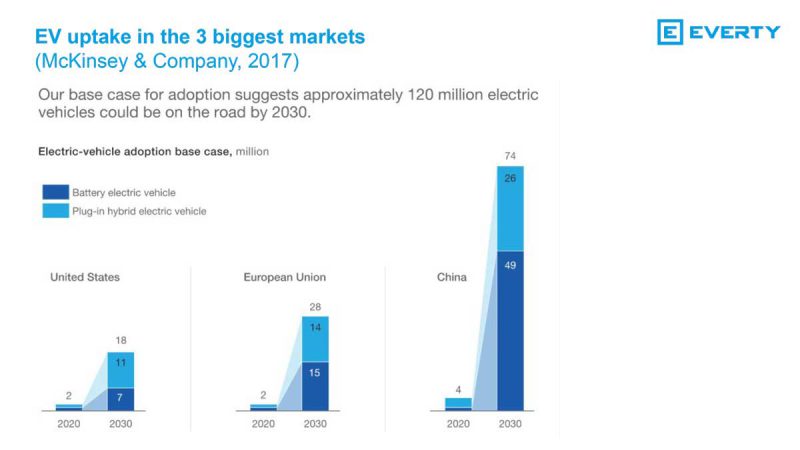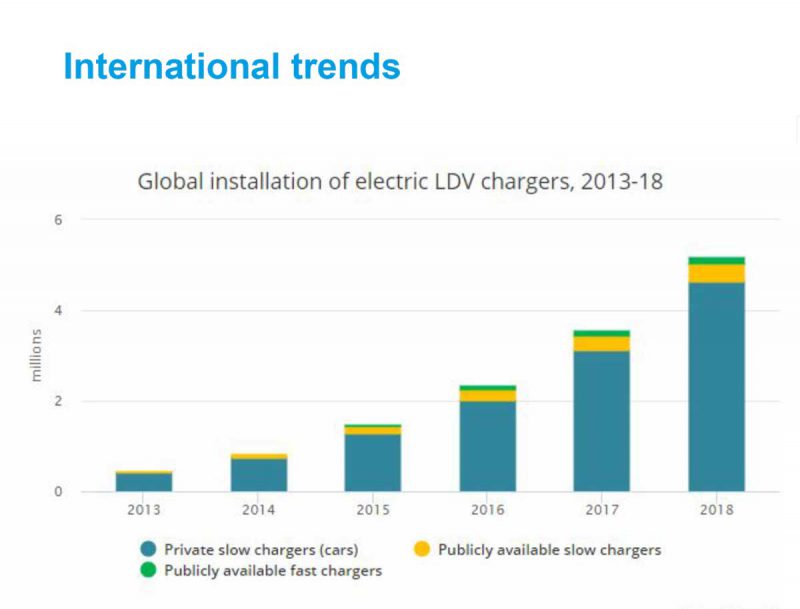By 2040 there could be as many 42 million electric vehicle chargers worldwide, and huge costs to upgrade the grid to cope with the increased demand for electricity can be avoided by ensuring those chargers are equipped to operate using smart software, CEO of charging software firm Everty Carola Jonas says.
Speaking at the Electric Vehicle Transition conference in Sydney on Tuesday, Jonas said that with at least 120 million EVs on the road by 2030 in the three largest auto markets alone – the US, Europe and China, as forecast by McKinsey & Company in 2017, there is a pressing need to consider how to charge them.

The drive to provide infrastructure spread across multiple markets, from DC infrastructure-focussed companies such as Australia’s own Tritium and Swiss conglomerate ABB, to oil giants Shell and BP, but the majority of charging will be done at homes, at work and at other “destination” locations, says Jonas.
Where there’s electricity, there’s a potential charger, Jonas explains. “Every building is a charging station,” she says.
“We need to reshift our thinking from having a petrol station that you go to, to [charging much more like] having a mobile phone,” says Jonas.
“There’s no limits to where we are going to see charging but we are not going to GO to a chargers unless we are on a highway.”
Out of the predicted 42 million chargers, and as much as 95% of those will installed ad hoc by homeowners and business owners, and this presents a particular conundrum, says Jonas.
“What that means for the electricity grid, is how do we manage that load on all the places when we don’t know where the cars are, or where the chargers are,” she says.

The answer, she says, is by ensuring that those chargers being installed are “smart”, and able to communicate data about how and when they are being, and how much electricity is being drawn via charging software.
While corporate development and apartment block owners are likely to choose these more expensive smart chargers because of the need to manage charging of (and organising payment for) a larger number of vehicles, homeowners, business owners are likely to opt for the cheaper “dumb” chargers that cannot communicate via software.
For fleet managers and apartment owners, Jonas says that its important to keep in mind the larger the fleet the more likely a building will run into load constraints.
“In most case you will have to do some upgrades [to account for increased load] but with smart charging you can avoid [more] upspeccing and upgrading,” she says.
Utilising charging software could also allow distributed energy exchanges, such as that being piloted by Greensync in Wellington, to better utilise EVs when not being driven as part of a “mesh” to smooth out the solar duck curve characteristic of a renewable-rich grid.
Whilst installing “smart” chargers at home has a higher upfront cost, they can also offer homeowners benefits such as being able to return accounting data back to work if charging a work car at home.
For business owners, it is important to understand the needs of a fleet or staff. Those hesitant to encourage a switch to electric mobility because of the high price of DC fast charger might be better off with several “destination” AC smart chargers.
“Look at your fleet composition and if you do have range anxiety put one DC charger and let the the cars charge slowly,” Jonas says.

Bridie Schmidt is associate editor for The Driven, sister site of Renew Economy. She has been writing about electric vehicles since 2018, and has a keen interest in the role that zero-emissions transport has to play in sustainability. She has participated in podcasts such as Download This Show with Marc Fennell and Shirtloads of Science with Karl Kruszelnicki and is co-organiser of the Northern Rivers Electric Vehicle Forum. Bridie also owns a Tesla Model Y and has it available for hire on evee.com.au.

